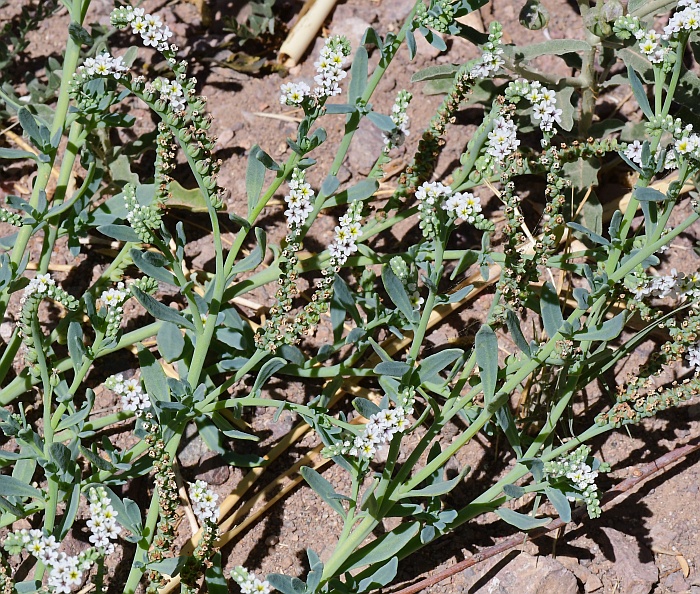Heliotropium curassavicum L.
Seaside Heliotrope

Native
CC = 2
CW = -5
MOC = 1
SRank = S1
© SRTurner
Heliotropium curassavicum L.Seaside Heliotrope | |
 |
Native CC = 2 CW = -5 MOC = 1 SRank = S1 |
© SRTurner |
|
Family - Heliotropiaceae Habit - Annual or perennial forb with deepset rhizomes.
Stem - Prostrate or loosely ascending from a spreading base, 10-40 cm long, somewhat succulent, glabrous, usually grayish-glaucous.
Leaves - Opposite, subopposite, and/or alternate, sessile or with a short, winged petiole. Blades 1-4 cm long, 3-12 mm wide, somewhat succulent, narrowly oblanceolate to narrowly elliptic, tapered at the base, rounded or more or less angled to a bluntly or occasionally sharply pointed tip, the margins entire, the surfaces glabrous, usually grayish-glaucous.
Inflorescences - Terminal and sometimes also axillary scorpioid spikes, these solitary or paired, sessile or on a stalk 1-3 cm long, densely flowered, lacking bracts.
Flowers - Calyces 1.2-2.0 mm long (sometimes slightly longer at fruiting), the lobes lanceolate to narrowly oblong-lanceolate, glabrous, more or less spreading after the fruit has dispersed. Corollas 1.5-2.0 mm long, 2.5-3.5 mm in diameter (measured across the spreading lobes), funnel-shaped to trumpet-shaped, white or occasionally bluish-tinged, usually with a yellow spot at the base of the lobes, glabrous on the outer surface, the tube 0.7-1.0 mm long, glabrous on the inner surface, the lobes 0.5-1.0 mm long. Stamens attached toward the base of the tube, the anthers 0.6-0.8 mm long. Stigma sessile or nearly so, the sterile appendage very broadly obconic and rounded at the tip or appearing disc-shaped with a small knob in the center, glabrous.
Fruits - Dry and drupelike, 1.5-2.0 mm long, 1.8-2.5 mm wide, globose to slightly depressed-globose, shallowly lobed at the tip, glabrous, eventually splitting into 4 nutlets (each 1-seeded). Nutlets with the dorsal surface smooth or faintly wrinkled, sometimes with 1 or 2 fine, blunt, longitudinal ribs, light brown to greenish brown.
Flowering - July - September. Habitat - Salt marshes, saline springs. Origin - Native to the U.S. Lookalikes - Distantly, Heliotropium indicum, which has similar inflorescences but very different leaves. Other info. - This species is known from only a single location in Missouri, near a salt seep in Cooper County, where it was first collected in 1976. The plant's tolerance toward saline conditions provide a competitive advantage relative to most other plants, which do not grow well under these conditions. The species is much more common in western and southwestern portions of the continental U.S., where salt-rich soils are more common. Photographs taken at Bosque del Apache National Wildlife Refuge, Socorro County, NM, 5-21-2025 (SRTurner). |